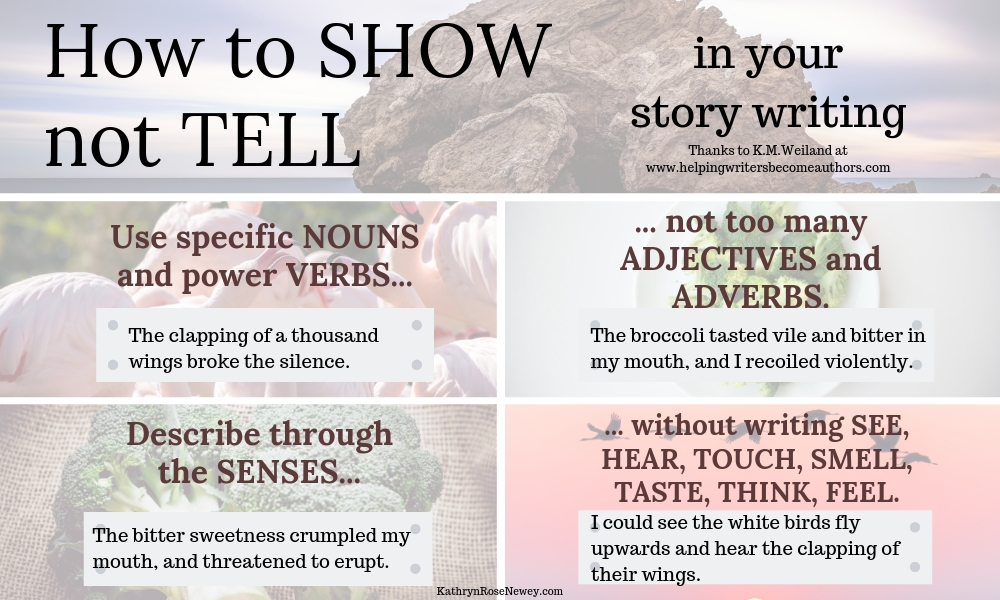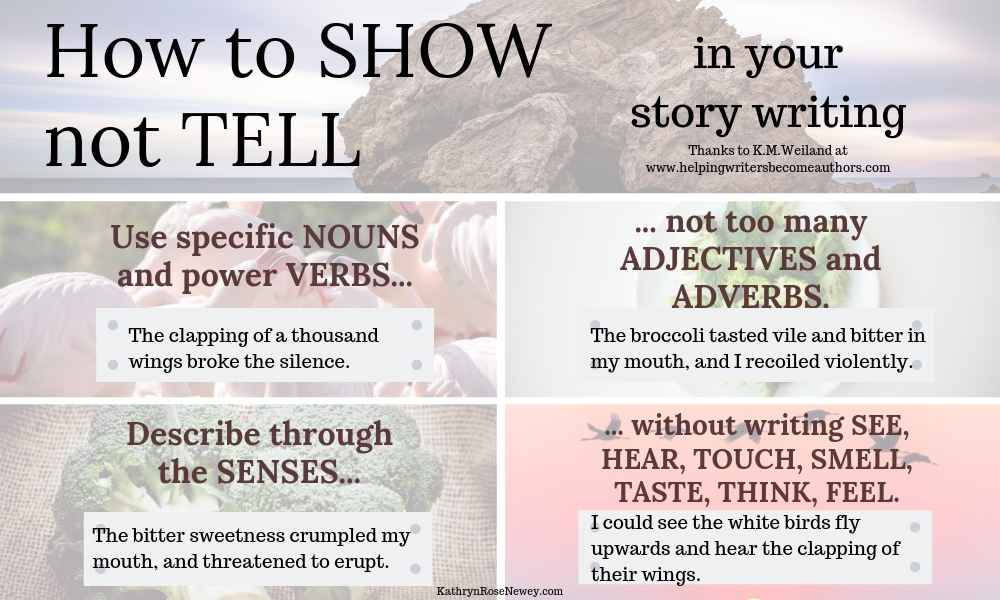We hear it all the time.
From the moment we start writing stories at school, to our high school creative essays, to every author training video and blog.
“Show, don’t tell!”
And it’s something that writers, especially new ones, grapple with… How to write from the heart, so that your writing sings, without being boring or cringeworthy.
At school we’re taught to use lots of interesting, powerful, unique adjectives and adverbs all the time!
But somehow that doesn’t (always) make writing soar.
Turns out the best writing teachers might be successful authors…
K.M. Weiland, an author and blogger, has extensive help and advice about the writing craft at her website HelpingWritersBecomeAuthors.com.
One of the most helpful summaries of this concept is her post “8 Quick Tips for Show, Don’t Tell“. Here’s a quick synopsis:
Don’t tell readers the emotion your character is feeling. Don’t say “Lucy felt regret…” Rather describe how she looks back and feels sad, or describe something that illustrates her regret, without actually using the word “regret”. [Metaphors spring to mind.]
Use cause and effect to your advantage. Writing chronologically takes readers with you, although sometimes writing about the effect before the cause can be powerful.
Avoid adverbs. You know those things we invariably use, when we write lazily? [This applies to adjectives too. Too many, and you might be using the wrong nouns!]
Choose the right verbs. Like the saying goes, if you’re using an adverb, you’re using the wrong verb.

Use paragraphs to break information. Like cause and effect, organising different aspects of a scene into separate paragraphs helps take readers along for the ride and helps to make the setting, the event and the result clearer in their minds.
Avoid saying “S/he thought” when writing what a character is thinking, because it should already be clear from the context when a certain sentence contains their direct thoughts.
Be wary of dumping too much information into scenes. Often too much background or explanatory information can be too telling, without enough showing.
Use character goals as your motivation for writing each scene. Focusing on actions which come directly from the character’s needs, goals and desires (and significant plot points) in the story will often lead to writing more show, less tell.

K.M. Weiland’s advice to those writers struggling to ‘show not tell’ in their writing is to use this suggested exercise from Mary Karr’s ‘The Art of Memoir‘:
Imagine you’re describing a significant emotional event in your own life. You’re not allowed to say how it affected you, or what you felt. You have to focus on the things that will imply or illustrate those things to the readers.
I made the “How to Show not Tell in your Story Writing” graphic to summarise the key messages about improving your ‘show not tell’ skills from another one of K.M. Weiland’s posts: “Showing and Telling: The Quick and Easy Way to Tell the Difference“.

In a nutshell, it’s down to elaborating (showing) not summarising (telling). To do that, use good quality nouns and verbs instead of adjectives and adverbs, and employ sensory descriptions, without necessarily naming the sense you’re describing. Obviously there is a place for telling as well, but showing involves readers more.
I’m going to get right to it after finishing this post! I’m going to try to make my writing more dramatic, submersive, real – and less telling.
What about you? What are your personal pet peeves with the ‘show don’t tell’ thing? How have you dealt with it? Do you have any useful examples we can all learn from? Write your comments below this post.
Man and smoke image thanks to intographics at pixabay.com.
Child in tunnel image thanks to Pexels at pixabay.com.
Girl and grain image thanks to tori_tori at pixabay.com.






